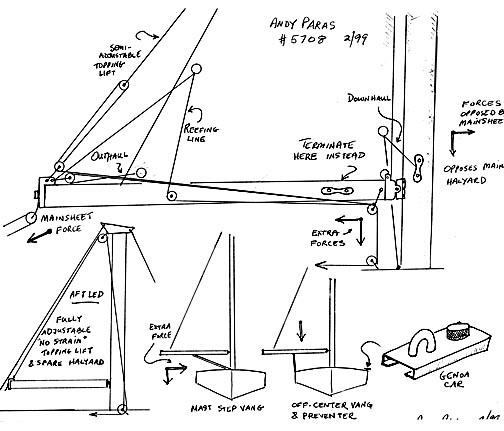
|
|
|
|
|
|
|
|
|
|
|
|
|
|
|
|
|
|
|
|
|
|
|
|
|
|
|
|
|
|
|
|
|
|
|
|
|
|
|
|
|
|
|
|
|
|
|
|

 Windblown - Gooseneck
Windblown - Gooseneck 
Two years ago, the mast fixed gooseneck on my 1988 C25 broke while I was on a dead run. The broken and jagged parts damaged the mainsail before I could head up and drop the sail. Thinking about it later, I realized that this improbably named device is pretty delicate compared with the forces being exerted all around it. it's worth considering this fact when designing your particular rig. Forces bearing directly on this part should be kept small. Where possible, they should instead be led directly to boom, mast, or deck.
(1) Boom Vang: Setting up the boom vang flattens the sail by pulling the boom downwards in the center. If the vang terminates at the mast step, it also produces a component of force that causes a powerful compression of the gooseneck. Better to use an off-center vang for long downwind runs. An added benefit is that the vang now ants as a presenter, although one led further forward would be more efficient A good idea that was mentioned in the forum is to terminate the vang at a genoa car attached to the toe rail.
(2) Aft lead Outhauls- Reefing Lines. Semi-adjustable topping lifts'. Rigs that lead these lines aft via blocks at the gooseneck add extra stress to the part. The lines cause forces directed downward and outward (aft) on the gooseneck. Less convenient, but perhaps better is to terminate these lines at a boom cleat. Also, you can create a fully adjustable, aft-led topping lift that doesn't stress the gooseneck by putting a block at the masthead, giving you an spare halyard in the margin.
(3) Downhauls: Adding a downfall attached to the deck and terminating on a mast cleat not only makes sail trim easier, but also opposes the upward pull of the main halyard. Without it, this force would bear directly on the gooseneck. You do introduce a component of force compressing the gooseneck into the mast. This force is opposed, while underway, by the sail acting on the mainsheet. leaving the gooseneck neutral.